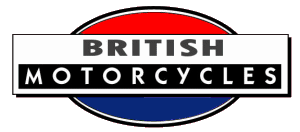


Avro[1] motorcycles were produced by aviation pioneer and aircraft builder A. V. Roe and Co from 1905 to 1926 and in 1957. Avro, perhaps best remembered for the Lancaster bomber of WWII, became part of the Hawker Siddeley group. (See also Harry Hawker)
1905 A. V. Roe disliked motorcycling without weather protection and proposed a motorcycle with extra-large mudguards.
1913 A design was produced named the Avro Motorcycle whereby the rider sat low, with legs either side of the Douglas flat-twin engine. There were to be Druid forks, wheel steering, rear suspension, a 72-inch/183cm wheelbase and outrigger wheels to stabilise the machine when it was stationary. Little more was heard of the design for several years.
1921 Harper Runabout was a motorcycle produced from 1921 to 1924 to a design by R. O. Harper of Salford. The machine was a three-wheeled scooter of a very practical runabout design. It had a single front wheel steered by long bars with the rider seated above and between the two rear wheels. A 269cc two-stroke Villiers engine drove one of the rear wheels by chain, through a three-speed gear. Enclosure panels provided ample protection and the machine performed well throughout a Scottish Six Days Trial. Although the Harper Runabout was thought to provide everything a discerning purchaser might require, its unconventional appearance, in the form of a motorised bath-chair, did nothing for its popularity. It is thought that its design, together with a downturn in spending power following the First World War, contributed to its failure.
1922 A machine was built called the Avro Mobile. It had low seating and, to begin with, was fully enclosed. It was fitted with a 349cc Barr and Stroud engine, three-speed Albion gearbox and all-chain drive. The frame was made of sheet steel formed into a channel section, with sprung front and rear suspension. It had hub-centre steering, 12-inch disc wheels and drum brakes. Although the machine started out with a completely enclosed body, this was soon revised to resemble a scooter-type with bonnet and front screen and a seat and tail behind. Under the hinged tail-panel lid was a storage space with the tools carried inside the lid.

Pioneer aviator Sir Alliott Verdon Roe designed and built this prototype and rode it many thousands of miles.
1926 The machine was road tested and the designer, who was by now knighted, introduced the Avro-Monocar.[2] This was fitted with a 343cc Villiers engine and three-speed gearbox with shaft and worm to the rear wheel. Once again it was almost fully enclosed and resembled the Mobile.
Later, it was to be renamed the Saro Runabout, to promote the new Saunders-Roe company.
Later still came the Arro model in similar form, but none of these really caught on.
1957 Around this time the Avle Bicar appeared. This had a Velocette 192cc LE engine, gearbox and rear axle in the same format. Yet again, only one was constructed.
Source: Graces Guide
Notes
1. Graces Guide speaks of Roe motorcycles in 1905, but no other reference has been found so that is perhaps an error.
2. The 1926 Avro Monocar is also referred to as the Ro-Monocar and the Avro Bicar.
If you have further information or a query related to this page, please contact us